How to Take Your Dog Mountain Biking.
Mountain Biking is one of our favorite activities to do with our dogs, it also has the greatest challenges. It’s too easy to forget just how far your dog is traveling while those wheels just keep a’ rollin’. Coasting down even a gentle hill… to the rider it seems like an easy ride, but to your dog it could be a burly sprint with few breaks.
While every dog is different, a good rule of thumb is to keep it under ten miles. Six to eight is even better.
To that end, it is critical that as our dogs caregiver, we have to ride for their enjoyment and their safety, more than for ourselves. We actually try to separate a mountain bike ride from a dog ride. A dog ride is slower, shorter and much more leisurely, often stopping to play in streams and take in epic views or watch wildlife. We also try to stick to trails that offer plenty of shade, and ideally, water. We also plan to take plenty of food and water breaks to allow our beloved pooch to catch his breath.
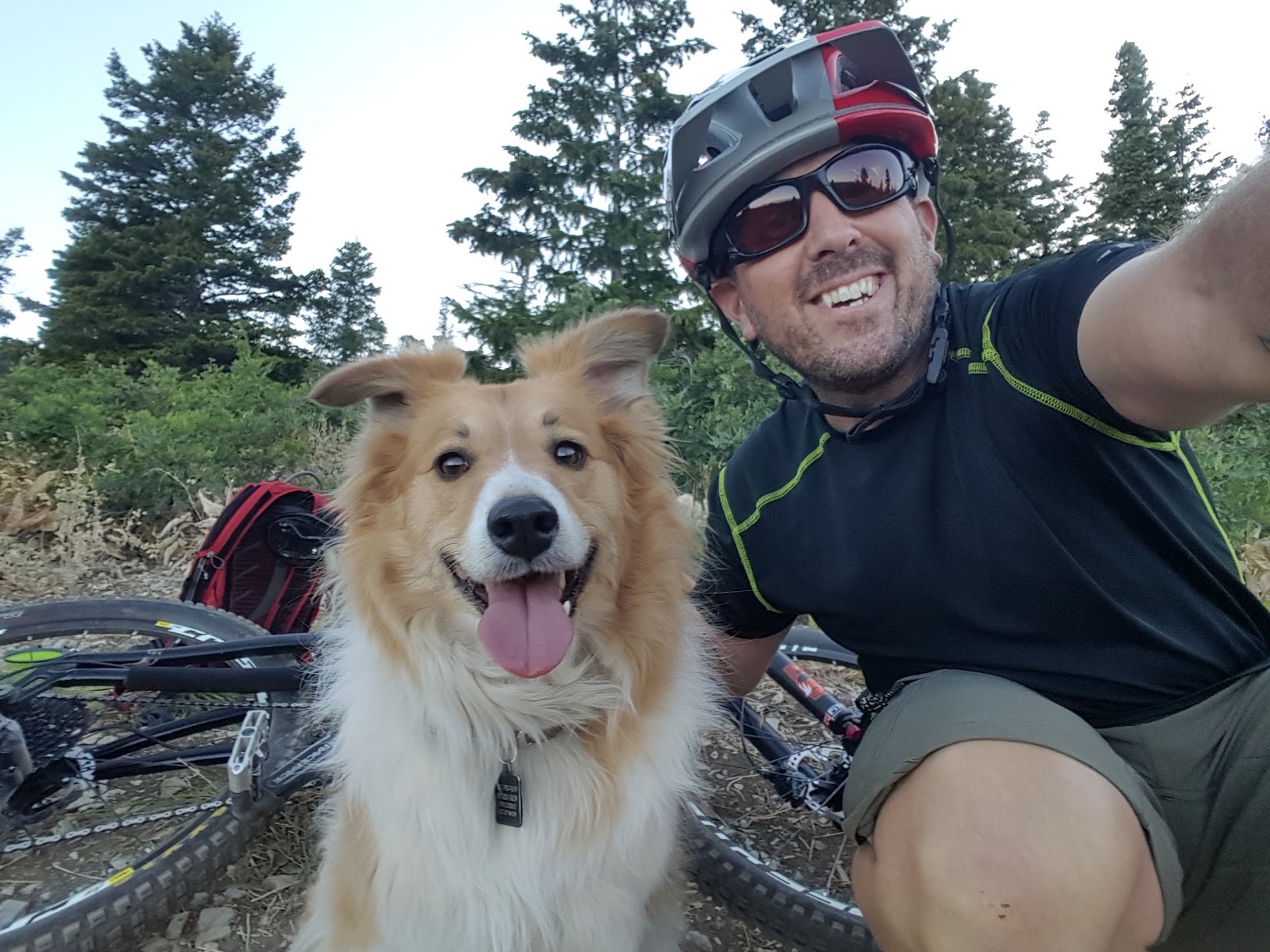
While every dog is different, a good rule of thumb is to keep distances under ten miles. Six to eight is even better. But some dogs, no matter what you do, love to run as hard and as fast as they can and will do so until they start tearing the pad on their feet. With dogs like this, it’s really easy to think they can handle more than maybe they should. More on that in a bit.
Additionally, most dogs are somewhat “macho” when they are out adventuring. They will bury any pain or injury and put everything into keeping pace. Remember, dogs evolved as a nomadic pack animal. Getting left behind isn’t an option, they will do everything they can to keep up with you simply because it is their nature to do so. This is also why your dog will likely extract so much joy from this activity.
And bikes put us on even footing, as it were, with our dogs. We can now travel at much more of an equal pace. Lets face it, hiking is pretty slow going for an athletic dog, which is part of why they run ahead, run back and run ahead again.
Safety
Be sure that you have read our Trail Basics. The risks of other riders who may be traveling too fast, or wildlife that you may encounter, means your dog should be really good with trusting you to get off trail when some other trail user is being less than considerate, and they need to know to trust you not to go chasing that moose or porcupine. But Mountain Biking is going to have some additional things you’ll need to be aware of.
Fitness
If you are just starting out, be fully aware of how fit your dog actually is. Most family pets spend their days lounging around the house with walks around the neighborhood. Just like you can’t expect to jump up after binging Netflix all winter and run a marathon, neither can your dog. You need to take time to slowly build fitness by starting with slower, shorter rides. Maybe even a mile or two, before venturing out on longer rides in steeper terrain.
Water
Even if your dog will lap up water dribbled out of your hydration pack, it’s not enough. You need to have a bowl and you need to have enough water to be able to give your dog as much to drink as they want. Remember, dogs don’t sweat. They modulate their heat through panting, and through their feet. If they get dehydrated they are in a bad way. You have to ensure, above all else, your dog has plenty of water. This is why we gravitate towards trails that have water if possible.
- Food-Grade Silicone, 2-pack Collapsible Dog Bowl
- Outward Hound Port-A-Bowl Folding Water Bowl
- Saim Folding Collapsible Travel Water Bowl
A collapsible bowl is a must. There are dozens of different styles to choose from, but we prefer the kind that folds flat. In fact, our collapsible dog bowl is pretty much always in our packs, even when we are not riding with our dog, and we’ve used it more than once to help hydrate someone else’s dog that was in trouble.
Overheating
Aside from water, there are a few things you can do to help prevent your dog from getting too warm. One of the easiest ways is to dribble water from your hydration pack onto their coat, specifically on their chest and neck, not their back so much, and strive to keep it damp. You basically provide the perspiration for them and allow evaporation do the rest. This may not work as well if you are riding in a humid climate, but it works brilliantly in dry climates.
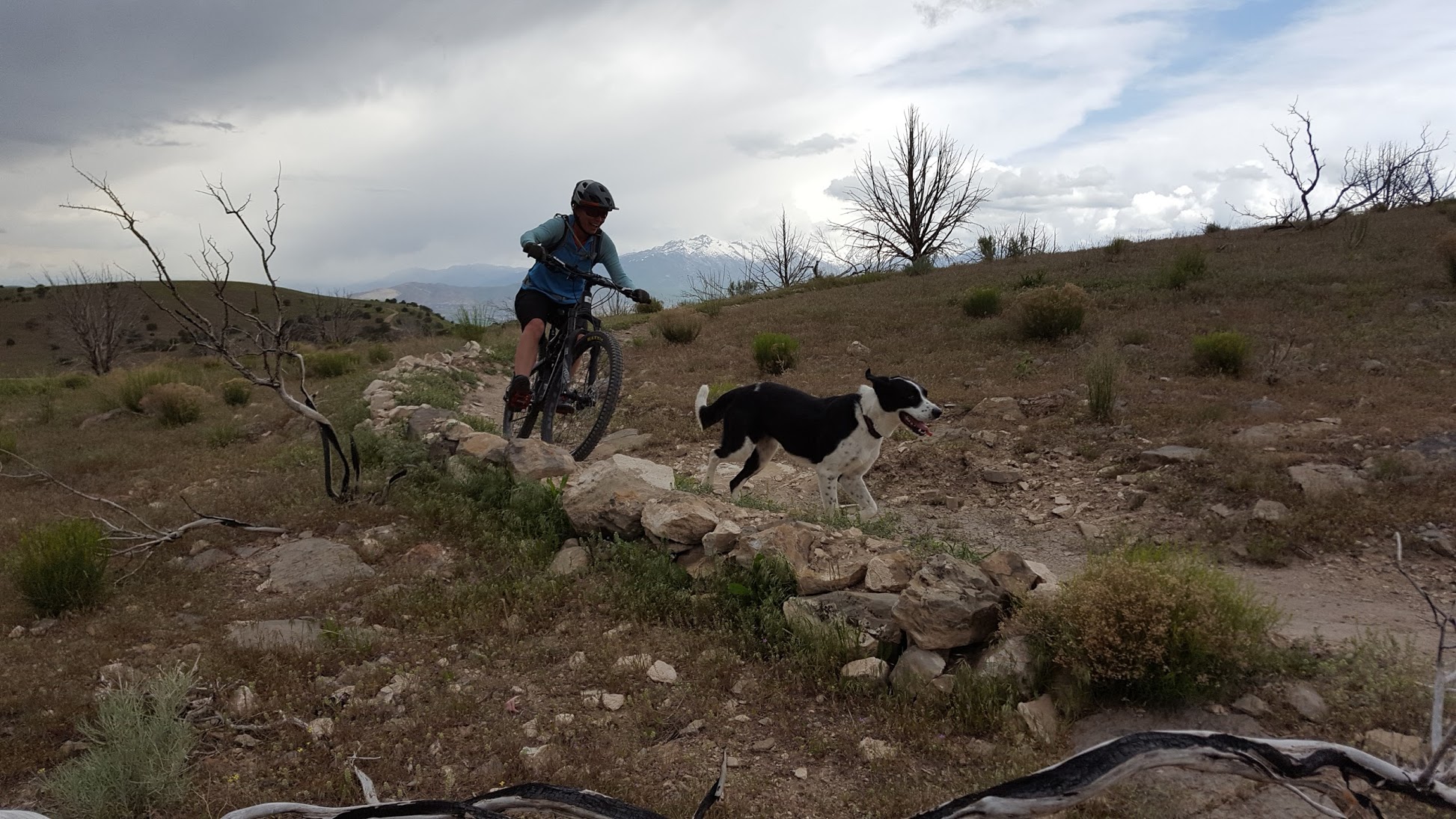 If you read our Trail Basics article, then you know of our fondness of simple cotton bandanas. They are great at making your dog appear less threatening, but you can also douse them with water. The cool, moist bandana around their neck is one more layer of evaporative cooling for them.
If you read our Trail Basics article, then you know of our fondness of simple cotton bandanas. They are great at making your dog appear less threatening, but you can also douse them with water. The cool, moist bandana around their neck is one more layer of evaporative cooling for them.
if your dog is black, you have to be extra, extra careful about overheating.
The market also has cooling vests that are designed specifically to help your dog stay cool. Ruffwear is a company that consistently offers quality products that are durable and functional.
And, finally, it must be said, if your dog is black, you have to be extra, extra careful about overheating. The radiant heat from the sun raises their core temperature significantly. Even on what you feel like is a cool day, could feel scorching hot to your pooch.
Fuel
Have you ever bonked on a ride? Sure you have, and your dog is susceptible to this as well. In addition to having training treats with you to keep your dog motivated to stay nearby, a company called Dog For Dog makes energy bars for dogs called Dogsbar.
First, Dog for Dog is an amazing company that donates a portion of every product sold to help rescue homeless dogs, but their Dog Energy Bars are amazing. While the bars are a little spendy, we cannot recommend them highly enough. Not only is the company great, the dogs just love the bars. We dole out one bar per ride, usually breaking into two or three snackings. It’s a good excuse to stop and give your dog a rest.
Peanut butter is always a favorite, but if your dog likes fruit, then we recommend the blueberry. Blueberry, incidentally, is good for keeping eyes healthy.
- DOGSBAR 100% natural nutrition-bar for dogs! Peanut Butter
- DOGSBAR 100% natural nutrition-bar for dogs! Blueberry
Feet and Paws
The terrain on which you are traveling is going to have a huge impact on how well your dogs feet hold up. In most cases, your dog spends their life on carpet, tile, hardwood, smooth concrete and manicured lawns. This means your dogs paws are going to need some time going at a slower pace and on mellower surfaces before you head out on some rocky trail, and especially on any sandstone.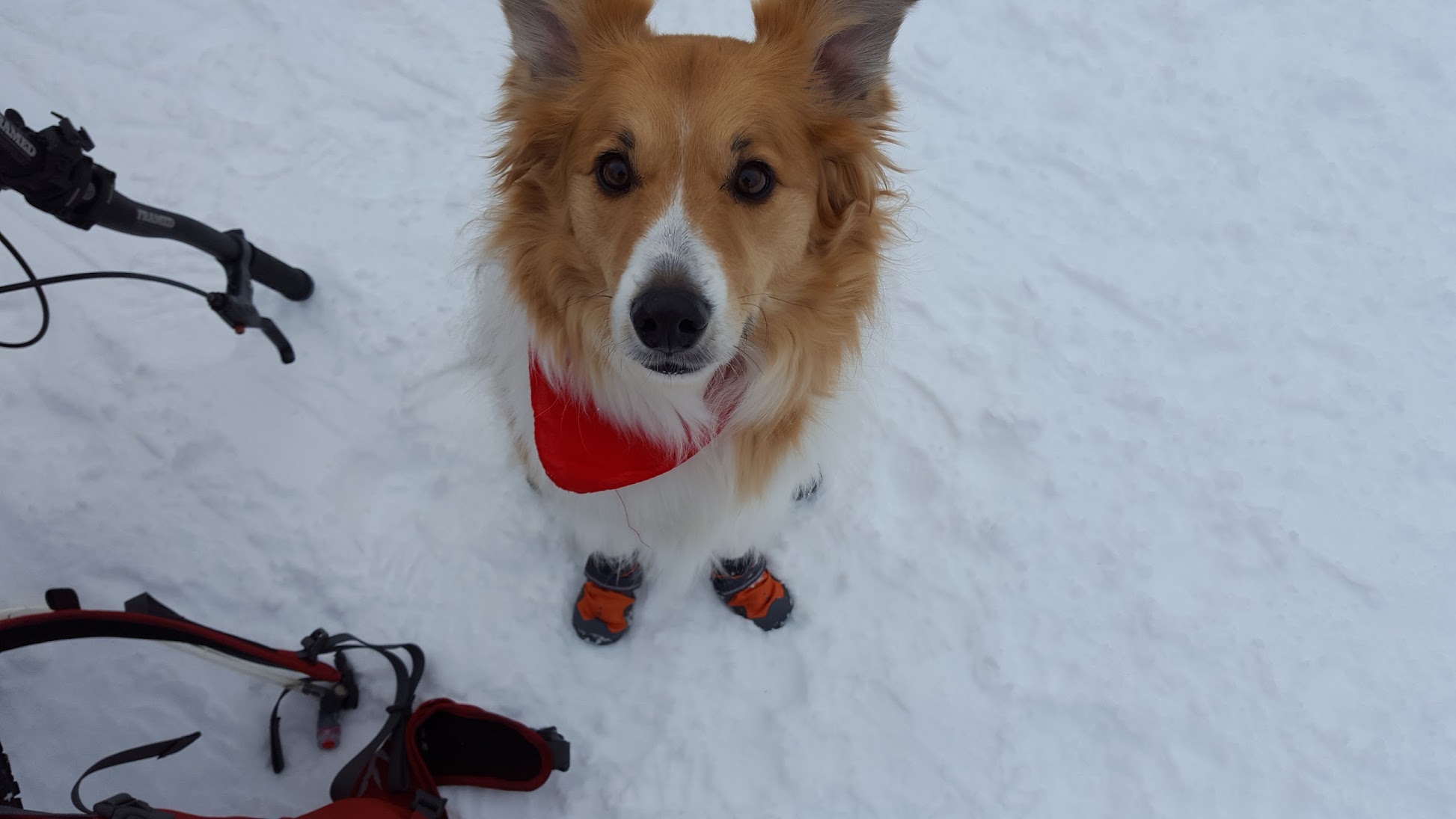
Just like you need to slowly build up your dogs fitness, you need to take time to allow your dogs feet to toughen up. Start by riding on “buff” trails. Asking your dog to charge down a craggy, rocky trail before their feet are ready will only serve to make mountain biking less fun for your them. Even if your dogs feet are up to the task, we recommend slowing down through rocky sections anyway. This will help prevent injured feet and ankles as well as torn pads.
Now, dogs are as unique as people and quite frankly, some dogs will love to run so intensely that they will charge ahead and tear up their feet no matter what, at least until they get a little older and a little slower. In this case, you either need to stick to smooth trails, or find a bootie that will help protect their feet. There are several options, with the RuffWear boots being the most durable. They offer a Grip Trex (with a Vibram sole even) that is the most burly, a Summit Trex which is a bit lighter and a Polar Trex for, as you would guess, winter.
There are other options that have been designed for sled dogs that may be more appropriate based on your dog and your terrain.
But before you order up a set, most dogs front feet are bigger than their back feet, so you may need to order two different sizes. Ruffwear offers boots in pairs as well as sets of four. For example, 30lb Chase wears a Small front boot, and an extra small back boot.
- Ruffwear – Grip Trex All Terrain Paw Wear
- Ruffwear – Summit Trex Everyday Paw Protection
- Muttluks All Weather Leather Sole and Toe Dog Boots
- Ultra Paws Rugged Dog Boot
In either case, keep a close eye on your dogs feet. In addition to booties, there are several balms and ointments that are designed to keep your dogs feet happy and healthy.
- Musher’s Secret Pet Paw Protection Wax
- PawsitiveFX Strong Paws All Natural Paw Protector
- Ruff Relief Organic Balm for Dogs
Recovery
Probably one of the biggest indicators to determine how far or how fast you should ride with your dog can be measured by their recovery time. If it was an appropriate length they should be active and back to their normal self by the next day. If it takes them a day or two to recover, then you pushed them too hard. Dogs simply don’t live long enough, and too much stress will just shorten that timeframe further. And it’s always better to err on the side of caution. You want to have fun with your pal, nut burn them up.
Always put the well being of your dog first
Seriously, there are few things I love more than sharing the trails with my best pal in the world, so much so that it breaks my heart to see the look on his face when I leave him at home. But despite trails that may not allow dogs, some trails just may not be suitable for your canine companion. A trail may be too long, too rocky, or have too much other mountain bike traffic. The key to Trail Doggin’ happiness is to always put the well being of your dog first.
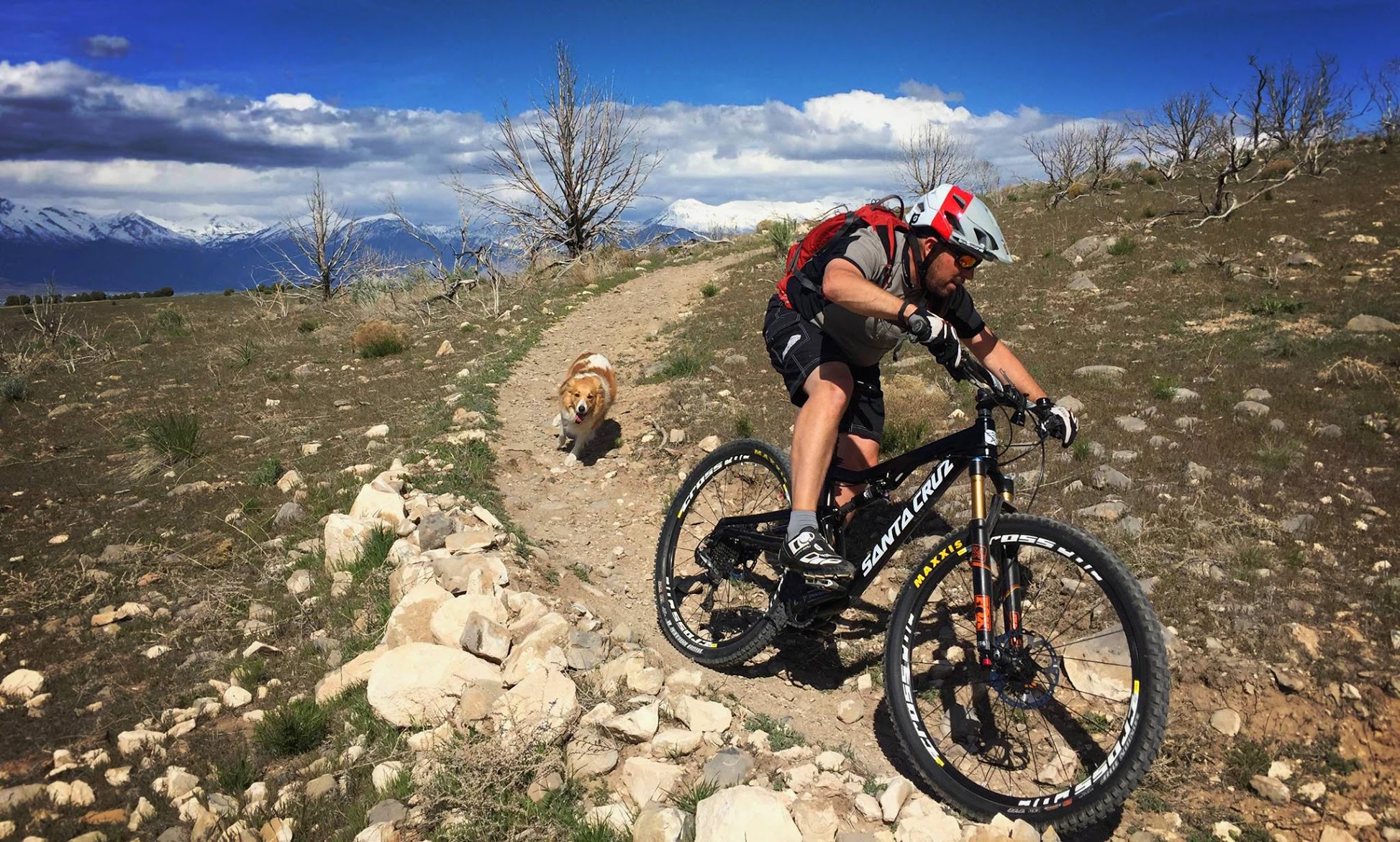
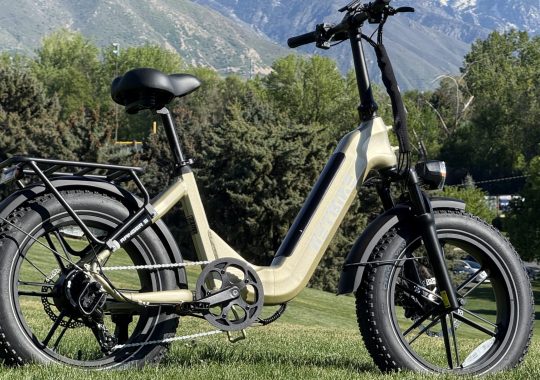
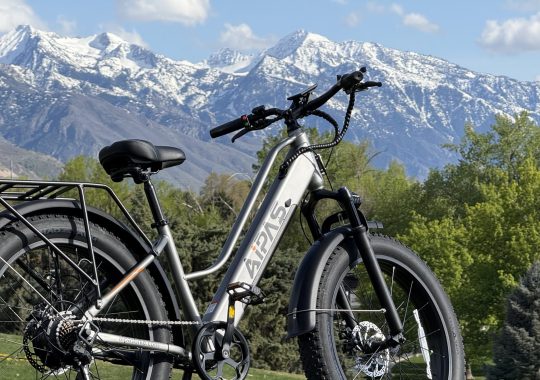
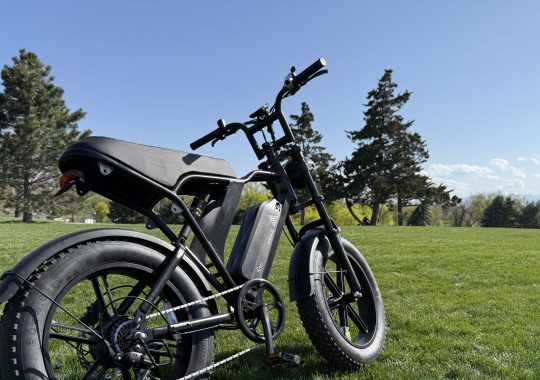
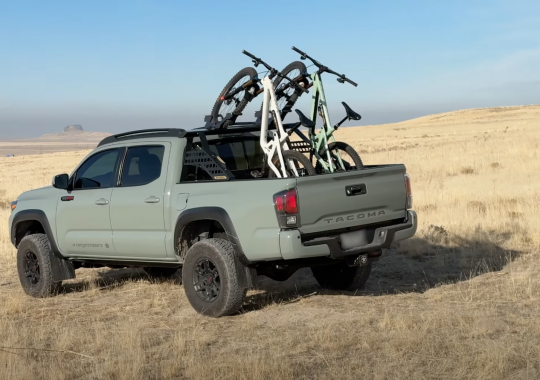
Thanks for this article. Your point about recovery time is really important and helpful. We’ve been wondering how long a ride is too long for our pup who just never slows down. Our last ride was 10 miles and although our pup happily kept up, we were worried that it was too long. We’ll be watching for this going forward.
Turns out I was over running my pup on our rides. Thank you so much for the tip!